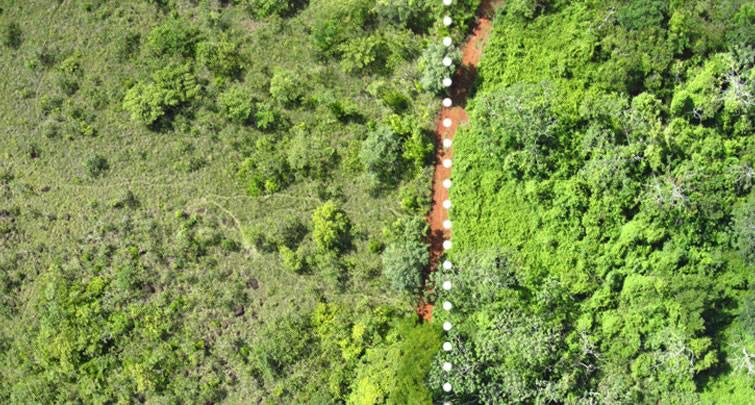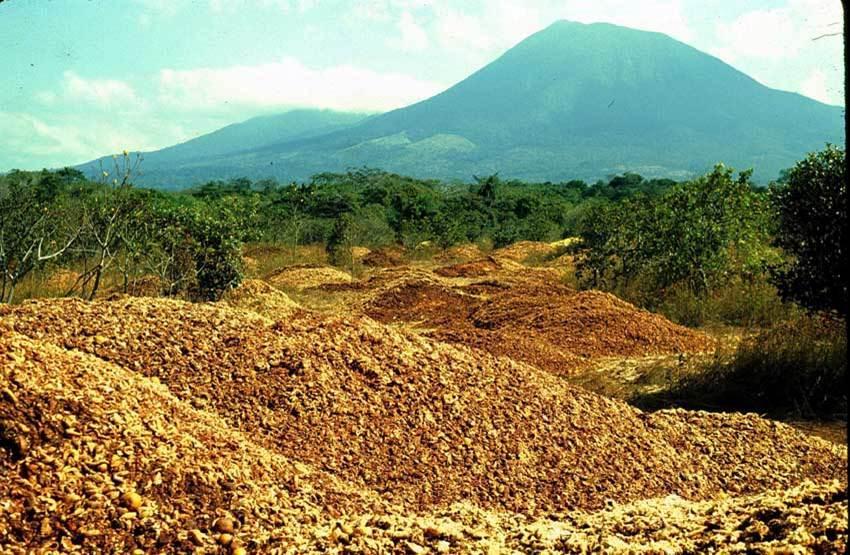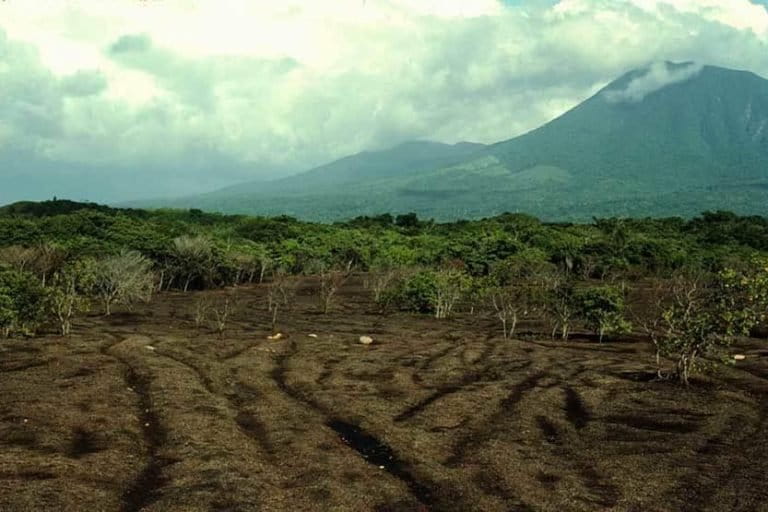- The peels and pulp of oranges applied to old degraded pastures as part of a public-private agreement to examine biodegradation of agricultural waste resulted in not only a successful biodegradation, but also dramatic improvements in soil productivity and vegetation cover.
- Researchers studying the effects of the application found that the area “fertilized” by processed orange peels had richer soil, a more diverse tree community, higher tree biomass, and greater forest canopy closure than an adjacent control area.
- The researchers suggest that similar initiatives would require: (1) a nutrient-rich anthropogenic waste, (2) suitable biological agents to break down the waste, (3) nearby seed sources and dispersers, and (4) amenable sociopolitical climate, including supportive policy and management.
- Agroindustrial by-products that are nutrient-rich but expensive to dispose of offer the opportunity for low-cost, scalable, biodiversity-friendly, carbon-sequestering restoration of degraded forests.
Researchers have come upon a new low-tech tropical forest restoration strategy, beginning with agricultural waste.
They studied the effects on soil and forest health of the purposeful deposition of tons of processed orange peels and pulp on centuries-old rangeland remaining inside Guanacaste National Park in Costa Rica. In their study, published this week in the journal Restoration Ecology, they found three times the number and diversity of forest trees, a 176% greater aboveground woody tree biomass, and a dramatic increase in soil nutrients where the agrowaste had been applied, compared to an adjacent control site.
The orange waste had been applied as part of an innovative public-private agreement to consolidate the conservation area and experiment with biodegradation of agricultural waste.
The experiment resulted in not only a successful biodegradation, but also dramatic changes in soil productivity and vegetation cover.

A public-private partnership, interrupted
The orange waste had been applied as part of an innovative public-private agreement to consolidate a conservation area and experiment with biodegradation of agricultural waste. In the mid-1990s, Daniel Janzen, a scientist working with the Área de Conservación Guanacaste (Guanacaste Conservation Area, or ACG), offered to take on the waste products of an orange juice company operating near the ACG in return for a donation of the company’s forested lands surrounding the ACG that were not going to be cultivated.
The company dumped a trial mass of orange peels and pulp onto an old degraded cattle pasture remaining inside the ACG in which the degraded and compacted soil had been overrun with jaragua (Hyparrhenia rufa), an invasive pasture grass that took over and kept other plant species from regenerating.

The 18-month trial period resulted in not only a successful biodegradation, but also dramatic changes in soil productivity and replacement of the grasses with native plants. This positive result encouraged the ACG to agree to receive the company’s processed orange residue for 20 years in return for 1,600 ha of intact primary forest.
In 1998, the company brought in 1,000 truckloads carrying over 12,000 tons of orange waste and used heavy machinery to spread it over 3 hectares (7 acres) in a layer 0.1-0.5 meters thick. This mass of material weighed 400 kg per square meter and was roughly 1 part organic matter, 4 parts water.
Application stopped because of a lawsuit from a competing juice company, and the waste sat without further treatment for 16 years.

Fast-forward to 2014, and the Princeton University researchers studied and compared changes in soil nutrients, as well as forest biomass, species, and regeneration, in plots that had been “fertilized” (covered) by the orange mulch and adjacent control plots that had regenerated without treatment.
They found that the huge deposition of the orange waste had disappeared, decomposed by larvae of several of the area’s fly species and associated fungi and microbes. That biodegradation transformed both soil chemistry and vegetation structure and composition.
Replenishing soil nutrients
The researchers measured the pH, organic matter, and available concentrations of eight nutrients in soil samples from plots in the control and treatment areas. In an email to Mongabay-Wildtech, lead author Timothy Treuer said, “we were pretty surprised to find that the fertilized area had a more neutral pH than the unfertilized area. This may have been because the orange peels were processed to remove essential oils for use in cleaning solvents.”
“The nutrient from the orange waste that disappeared to the greatest extent from the top 10cm of the soil was phosphorous, not leaching-prone potassium,“ said Treuer. “This observation, together with the absence of nitrogen-fixing species from the unfertilized control area suggests the addition of phosphorous may have had an outsize impact on plant growth at the orange peel site.”
Fellow author Jonathan Choi hypothesized that, “the addition of nutrients like calcium and potassium were able to shift the overall pH of the system towards one that is less prone to leaching [a major deplete of tropical forest soil nutrients].” Unfortunately, he added, “it is difficult to [confirm] because we lack a time machine to get us back to 1998 to observe the system more closely.”
Enabling a more robust, diverse plant community
Tropical forests support more tree species than other ecosystems, but what eventually grows back on soils that have been repeatedly burned, compacted, and cultivated is a simplified, depauperate system dominated by a few species resistant to fire and cattle.

The early anoxic conditions created by spreading the massive orange waste over the initial shrubs and grasses killed their roots, an important step that made the “fertilized” site available for other plants to grow.
Treuer told Mongabay-Wildtech, “Fire management has been one of the central tasks of ACG staff over the last three decades in ensuring the continued health of the park. Interestingly, fertilization with orange peels may have added a lot of fire resilience to the system; by suppressing grasses and speeding canopy closure, the orange waste makes the scourge of tropical forest restorationists less of a risk.”
The researchers quantified the changes in the vegetation structure and tree community by measuring and identifying trees within three meters of several 100 meter-long line transects within the orange waste treatment area. They did the same within the pasture on the other side of a road that had not been covered in orange peels.
They also took hemispheric (“fish-eye”) photographs of the canopy, which “showed significant increases in canopy closure in the area where orange waste was applied relative to control.”
 |
 |
| Hemispheric photos of tropical rainforest vegetation plots: the regenerating plot on the left has low woody biomass, with 4 trees species plus bamboo and lianas, whereas the more mature plot on the right has a higher biomass, 9 tree species, and no bamboo. Photo credit: Sue Palminteri | |
The improved soil from the orange mulch led to the growth of larger trees from an enhanced array of tree species: fertilized plots contained 24 species, while just eight tree species remained in the control transects. These trees were larger with three times the wood growth found in the control site.
The authors state in their paper, “The effect of the orange peel deposition on edaphic conditions was dramatic and could serve as a reasonable partial explanation for the difference in tree species composition and aboveground biomass between orange waste treatment and control.”

Orange is the new Green
Secondary forests support more biodiversity than degraded pastures and shrubland and sequester carbon dioxide, so restoration of degraded forest land is an increasingly common conservation goal.
However, the complexity of tropical forests makes their restoration expensive, so there is equally great interest in finding low-cost tools that contribute to regrowth.
The authors state in their paper, “Depositing the orange waste on this degraded and abandoned pastureland greatly accelerated the return of tropical forest, as measured by lasting increases in soil nutrient availability, tree biomass, tree species richness, and canopy closure. The clear implication is that deposition of agricultural waste could serve as a tool for effective, low-cost tropical forest restoration, with a particularly important potential role at low-fertility sites.”

In an email exchange, Treuer told Mongabay-Wildtech, “We’ve identified a few factors as essential for this sort of initiative: (1) a nutrient-rich anthropogenic waste, (2) suitable biological agents to break down the waste, (3) nearby seed sources and dispersers, and (4) amenable sociopolitical climate. The first three conditions are probably fairly common in a world where degraded tropical forests are now greater in extent than intact tropical forests.”
Regarding the waste from other crops, Treuer added, “We think there’s a wide variety of nutrient-rich crop residues or other agroindustry byproducts that might have a similar result in terms of fertilization and weed suppression. I heard rumor there are already trials underway at a site in Costa Rica using waste coffee cherries.”
These agricultural waste streams are both increasingly common and costly to dispose of, suggesting opportunities for low-cost, carbon-sequestering ecological restoration.
“We think the next step is definitely carefully controlled trials and experiments with a variety of ag wastes in a variety of degraded land settings,” said Treuer. “We don’t want to give license to the agroindustry to improperly dispose of their wastes willy-nilly, but we certainly want to encourage cautious collaborations between businesses and researchers in heavily degraded lands with nearby seed sources and seed dispersers.”

In their paper, the authors conclude, “Lower-cost tropical forest restoration methods, particularly those framed as win–win business-protected area partnerships, could dramatically increase the scale of tropical forest restoration activities, thereby providing a variety of societal and ecosystem benefits, including slowing both global biodiversity loss and climate change.”
Reference
Treuer, T. L., Choi, J. J., Janzen, D. H., Hallwachs, W., Peréz‐Aviles, D., Dobson, A. P., … & Wilcove, D. S. (2017). Low‐cost agricultural waste accelerates tropical forest regeneration. Restoration Ecology.
Banner image shows the 1997 initial biological survey of the site in northwestern Costa Rica to receive the orange waste treatment. Photo credit: Dan Janzen & Winnie Hallwachs
